-
Bell ringers turned into a full lesson
Posted by ALICIA CHATHAM on 4/10/2018
Today in first period we used our space in an amazing way! We started with each student coming in to the room to find that our white space had been taken over before notes even started! As students came in to get settled, they were instructed to sit in between two people that they did not sit next to yesterday, ad then to choose a problem from the board to work.
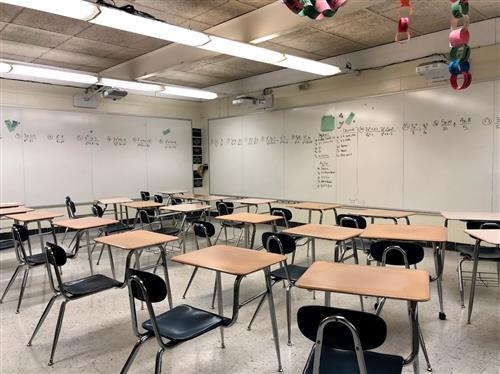
The activity was intended simply as a bellringer, but it became apparent that the class was not comfortable doing the problems unassisted. So, with our mindset of "learn it before we leave it", we jumped in head first to these problems.

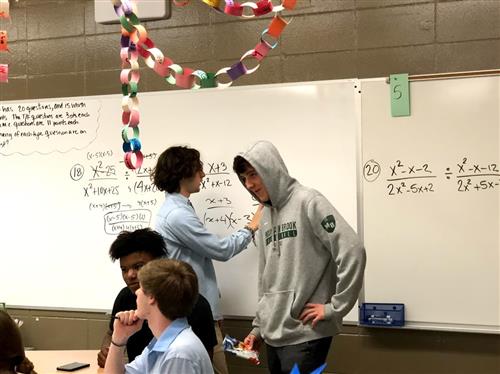
Students worked individually to complete his or her own assigned problem, and then moved on to helping classmates once they finished. This is actually my favorite part of the new set-up! Students feel more comfortable working with each other sometimes than they do asking me for help. It is so great to have so many teachers in the class at all times! It is really a great help.
Once the problems were completed, we went over them as a class and held a Q & A session for the more difficult ones. This only left us a few minutes to work on that day's notes, but the students were so much more confident ablout what they learned that day that it was 100% worth it!
-
Gratitude
Posted by ALICIA CHATHAM on 4/4/2018
This is a gratitude chain. On the first hundred or so links, I wrote the names of each of my seniors. Every week, they each will write on a link one thing that they are grateful for and attach it to the chain. That way, next year when they are off taking over the world, and they get nostalgic, or overwhelmed, or just need a soft thought to land on, they can remember that there are thousands of things to be grateful for. And they will know what gratitude looks like- it looks like a paper chain hanging from the ceiling of a math class :)
-
Visually Random Groups or How to Build a Proper Pyramid
Posted by ALICIA CHATHAM on 12/15/2017 8:00:00 AMIn my last post, the Discrete math classes had begun work on the Sierpinski pyramid in our unit on fractals. This seemed to be a great way to casually introduce the concept of VRG (visually random groups) to the students. We will discuss VRG in a later post.
The students worked collaboratively every day on this project. Each class picked up where the previous class had left off. We began with a discussion of what the pyramid should look like, and how each iteration of the pyramid would be connstructed.
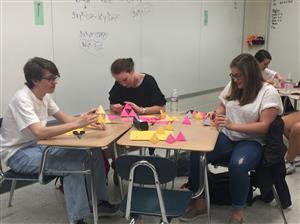
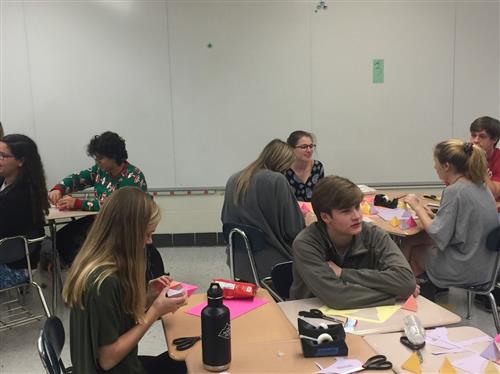
Students worked to copile a large number of 4th iteration pyramids.
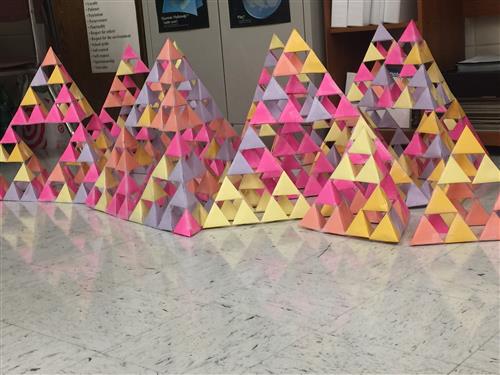
Once these were consructed, the classes realized that assembly would have to take place in the Mall area of the school. The students truly enjoyed this part of the project and had so much fun explaining their work to the people that went by!
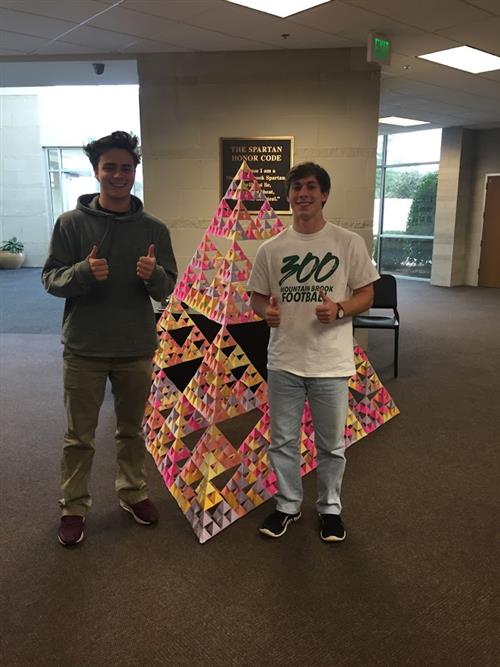
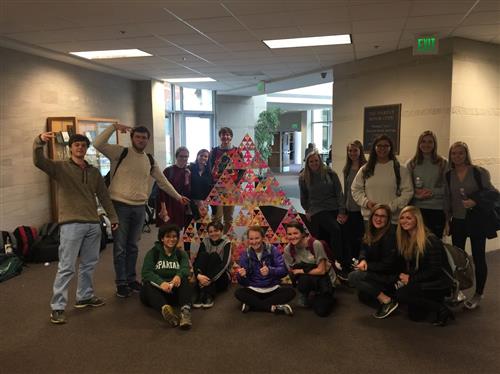
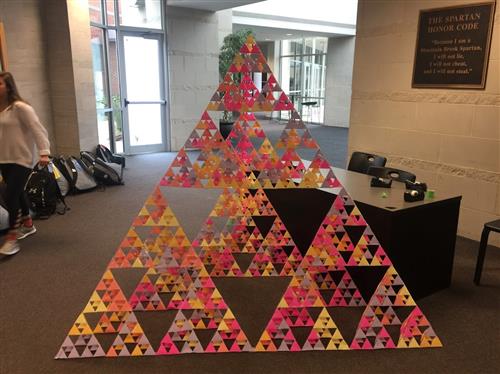
-
Fractals in Discrete Math
Posted by ALICIA CHATHAM on 12/6/2017One of the best things about teaching discrete math is that I get to do some pretty incredible mathematics with high school students. Think of it as a topics course from college, only on the high school level. We cover several pre-calculus topics, as well as number theory, graph theory, election theory, logic and counting. The last thing we are covering this semester is fractals and tessellations. (I saved the fun stuff for the tired days at the end!)
The classroom has been like a bee hive- in constant movement since we started the unit. Day one started with a brief lesson on fractals, their history, how fractals appear in nature and the Mandelbrot set. Day two put us to work constructing fractals using a clothesline math activity. This is an activity where a clothesline is used to help students sort and organize through the problem.
In our case, students were given the first two iterations of a fractal and had to order the rest on the clothesline. Students also created their own fractals for display on the clothesline.
An interesting side note to the clothesline activity: My students were using the boards to help with the organization of their thoughts. We are used to seeing students work out math problems on the white boards, but this was actual writing down their thought processes!It was incredible! This ties in seamlessly with what I have been reading about on Twitter. Classrooms using VNPS (vertical, non-permanent surfaces) to assist students with their organization and thought processes. You can read more about that by searching the hashtag #VNPS on Twitter or by reading Peter Liljedahl's original research HERE.
Currently students are working on creating a class-designated fractal- the Sierpinski pyramid. The next post will discuss the project and how using Visually Random Groupings influenced the outcome.
-
But MsC, Why Are the Desks Different Every Day?
Posted by ALICIA CHATHAM on 11/28/2017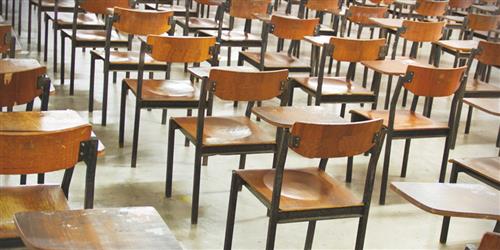
I will be the first to admit it: I am like a toddler; I have a desperate need for structure. Because of this personality quirk of mine, in the past, things were more structured in my classroom. Desks were in rows, except on group work days when they were in groups of four. Notes written using the document camera and then projected to a screen in the front of the room. Students taking notes or working on a review, or having what I call a "struggle day." (Struggle days are days when a student needs help, they have to ask each other, use their notes or the text before asking me to step in. Being able to handle a productive struggle is a valuable tool in math and in life.)
Side note: Please don't think when I talk about structure that I mean inflexibility. In a high school, if you are not flexible, you are not happy. At least not for long.
Over the course of this year, I have become more and more unstructured. Don't get me wrong, I have a planned lesson. Notes are prepared. I know what standards will be covered and what targets I want to see the students reach. But the rest, well... that has become more fluid. The connective tissue that holds the class together has become this amazing thing that bends and gives based on the needs of the class.
Again- I know that others may be reading this and saying, "But, Morgan, shifts are made all the time in the classroom to adjust for what happens that day." Those people are right. I used to make those same, calculated shifts. And it was not that I planned for each contingency, but at this point, I know what had to give to get to where I wanted to go. But now things are a little different.
It is not uncommon for notes to end abruptly and everyone be paired off to do some work. Or maybe I realize that I am not articulating a topic well, but a student is giving serious help to his or her group- I will ask him or her to step in and lead the class for a minute. Or maybe things have been very fluid for most of the class and I rope everyone back in for a pop quiz. (Fluidity goes both ways!)
What I have come to realize is that as long as I have my destination, the compass to get me there, and I am open to where the road (or side road) takes me, my classroom and my kids are going to be just fine. We will learn the math, and hopefully, other valuable lessons along the way.
-
Algebra 2 Steps Up and Does a Video Review
Posted by ALICIA CHATHAM on 11/13/2017With all of the changes to my Discrete Math classes, there was bound to be a little over-flow. You know how it works. When you do something for one class, no matter how many students are in your school, your other classes somehow find out and want to know when they get to have, do, join, use...
Well, that has started happening to us in room 109. My Discrete Math classes worked on a video review last week and the Algebra 2 class decided that they wanted a go at it. I have to say- they really stepped up!
The kids were so amazing and engaged in the process. And they all felt that having to teach the review material helped them to understand it better themselves. (Yay! Mission accomplished!!!!) These are a few photos from the students' first attempt at the videos. I think they did a great job!

Austin recording students working on our new white space. He then upoaded the videos to Canvas.

Mary Hannah and Harold working to explain solving a quadratic using a factoring shortcut.

Selim and Harrison using a Chrome Book app as the writing surface to explain their quadratic problem. Their work was then uploaded to canvas as a study video.
As you can see we have three different groups, three different types of problems, three different uses for the white space. Every day is different and it is because of what we have to work with now in our classroom. I LOVE THIS WHITESPACE!!!
-
Our First Attempt at Video Discussions
Posted by ALICIA CHATHAM on 11/3/2017This week, we are using our new work space in a completely out-of-the-box way! Each student was assigned a problem. They were responsible for working through this problem until they could do it in under one minute, while fully explaining the problem. Once the students were comfortable, I assigned them a twist: Another student would video them (using their cell phones) presenting the problems using our new workspace. The students then would post their videos on to Canvas in a discussion board. Over the upcoming weekend, students will watch and comment on four videos.
Since this is our first attempt at all of this, we worked collaboratively on the problems as well as how to best facilitate the uploading. Since each student has a Chrome Book, we had several options!
- option 1: Use the Chrome Book to video directly into your drive, then upload from your drive to Canvas.
- option 2: Use your cell phone to video, then save to drive app on the phone and use the Chrome Book to upload to Canvas.
- option 3:Use the cell phone to video, and use the Canvas app to upload directly from your phone to the discussion board.
Most students chose option 3, because it streamlined the process. (The issue with the Chrome Books was that to use the camera, it was awkward to hold and film.) Additionally, where the comments are concerned, we agreed as a class that for this first venture, our comments should be limited to production-relevant statements.
For example:
- "The camera angle is not showing enough of the problem,"
- "We cannot hear you, please speak up."
- "I understand what you were doing in the problem, but I am afraid that if someone was confused on how to do the problem, they would not follow you. Maybe explain each step."
Our hope is that as we improve this process, each class will be able to use this as a review tool for tests and quizzes. Below you will see some still shots of the kids in action and the work that they all did. It was great fun!





And comments have started coming in as well! I am so proud of how they are working together to build this as a collaborative way to work through the math. Here are a few snips from the canvas discussion (names blacked out):



-
Two Projectors are Up and Running!
Posted by ALICIA CHATHAM on 10/25/2017Late yesterday afternoon, the new machine was installed to run the projector set-up. Two of our projectors were connected to the new machine, so now we can start using the new set-up! Today was a review for tomorrow's test, so students worked in groups on the review. This was a progressive problem set, meaning that there were problems of different difficulty levels on the review. The kids worked through them like champs! I set up the documents on their screens, and the students would use the wireless mouse and keyboard to advance through the document. It was a great first day with the tech!



-
Working Out the Kinks
Posted by ALICIA CHATHAM on 9/20/2017We stepped out today and tried out our new board space! Each student was assigned to a group and each group was assigned problems to work. The students were to work collaboratively within their groups to solve the problems. The hope is that as issues come up, the students will help each other and draw on each other for help and support. Here are a few pictures of groups in action!

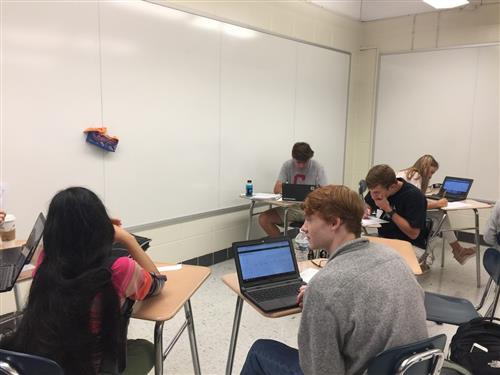




-
Installations in Progress!
Posted by ALICIA CHATHAM on 9/13/2017There have been some changes in my classroom! Just look at what has been installed!!
First, the boards were installed:


Then the projectors came in!


Things are really coming together! I can't wait to get all of this working together and have the projectors hooked up!
Menu
Mountain Brook Schools
"Providing an effective, challenging, and engaging education for every one of our students"
- Home
- Teaching & Learning
- Institute for Innovation
Mountain Brook Schools
32 Vine Street
Birmingham, AL 35213
Phone | 205-871-4608
Fax | Call for Dept. Numbers


